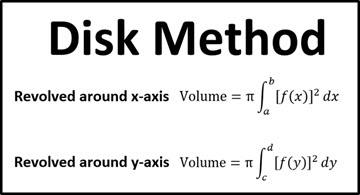Math: disc and washers, shells, length, surface area
1/12
There's no tags or description
Looks like no tags are added yet.
Name | Mastery | Learn | Test | Matching | Spaced |
|---|
No study sessions yet.
13 Terms
Discs and washers
When you draw them, it’s PERPENDICULAR
In terms of x is dx
In terms of y is dy
It helps to draw things out
Discs and washers formula
π ∫ R2-r2

Discs and washers formula when you’re revolving around a specific line
DX if line is PARALLEL to x-axis = Top-bottom
DY if line is PARALLEL to y-axis = Right-left
SHELLS acronym
SEO — search engine optimization but irl Shells Opposite
Opposite in that the axis and the differential are opposite
Revolving around X axis = DY
But DY is in terms of y
Revolving around Y axis = DX
But DX is in terms of x
SHELLS formula
2π ∫ (x)(f(x)) dx
2π ∫ (y)(f(y)) dy
Shells around a specific line
Just add that line onto the x or y (not the function)
Shells HEIGHT when area is between two curves
Top-bottom DX
Right-left DY
Attach to actual function (not the x or y)
Length of a curve - remember
bounds are in x, then DX
bounds are in Y, then DY
Length of a curve formula
∫√1+derivative2
Surface area and formula
Revolving around X axis: DX
Revolving around Y axis: DY
Formula: 2π ∫ f(x) • derivative2

x = asinθ
cos2θ = 1 - sin2θ
like 1-x2
You can remember because the 1 at the start is like the beginning and like sin is the first one

x = atanθ
sec2θ = 1 + tan2θ
Can remember because this is the only one with + and “t” in tan looks similar

x=asecθ
tan2θ = sec2θ - 1